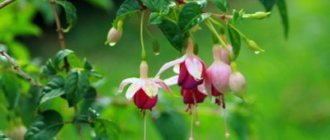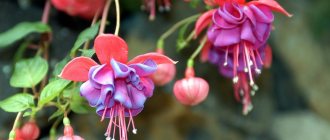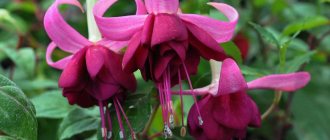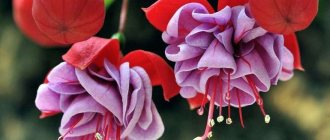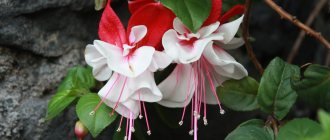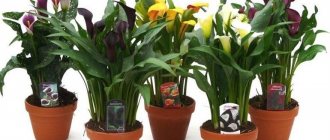Hybrid fuchsia is a popular garden and indoor plant; it does not overwinter in open ground in Russia. In the West, it is often grown as an annual crop; at best, the queen cells are left until spring for propagation. The most versatile is the ampelous fuchsia - it can be planted in a hanging basket, a stationary flowerpot, a flower pot or in a high flowerbed.
Fuchsia flower, photo
- Fuchsia variety Fuchsia Beautiful;
- Fuchsia variety “Little Bell” (Litte Bell);
- Fuchsia variety "Annabel";
- Fuchsia variety “Fuchsia Magellanica” (Fuchsia magellanica);
- Fuchsia variety “Millennium”.
Ampel varieties
The ampelous shape of fuchsia creates a festive mood. Varieties of these flowers take root well on terraces and balconies in hanging flowerpots. Plants in pots that decorate arches and bridges look very beautiful.
Golden Marinka
The flower has weak branches and blooms profusely and luxuriantly. Marinka's shoots are small, only up to 30 cm. Cuttings take a long time to take root. The shoots are strong and strong and do not break off, however, pinching the apical buds is necessary to preserve the aesthetic appearance.
The leaves are medium-sized, variegated, from light yellow-green to deep yellow. Oblong and smooth, the tip is pointed. The flowers are simple, semi-double are less common. The size is medium, the skirt and sepals are bright red.
It must be taken into account that the variety is susceptible to excess moisture.
Isisl (Icicle)
One of the most delicate fuchsia varieties. The bush is vigorous. The shoots are reddish in color and do not become very woody. Flowering is abundant and lush.
The leaves are rich green, the veins are red-brown. Medium size, smooth, oval in shape with a pointed tip. The flowers are very large, with long light milky sepals and a voluminous pale pink skirt.
The variety does not tolerate sunlight and gets burned quickly. Cuttings take root with difficulty, so it is quite rare to see such fuchsia.
First Love
Also a rare variety. Characteristic features: rapid growth and branching, graceful shoots, elongated buds.
The leaves are dense, elongated oval in shape, medium green in color. The sepals are snow-white, slightly powdered with a light pinkish haze. The skirt is fluffy, a delicate pink shade, with a pink blush at the base. The flowers are large.
Cuttings take root slowly and with difficulty. Like most fuchsias with light flowers, they quickly get burned.
Fuchsia bush varieties, photo
- Fuchsia Lady Thumb;
- Fuchsia Krommenie;
- Fuchsia bush terry;
- Fuchsia Fuchsia Triphylla Flore Coccinea;
- Fuchsia Bella Fuchsia;
History of appearance
Belongs to the fireweed family.
About 90 varieties of fuchsia (fuchsia) are known. The natural environment for the culture is the climate of New Zealand, Central and South America. In these countries it grows as a perennial shrub with an evergreen crown. The flower has been cultivated at home for more than 2 centuries. There are many different hybrids and varieties. They were named after the botanist Leonard Fuchs (German scientist and doctor).
Fuchsia ampelous, photo
- Fuchsia ampelous Saskia vander Heijden;
- Fuchsia ampelous Marinka;
- Fuchsia arborescens;
- Fuchsia Trailing Dark Eyes;
- Fuchsia ampelous Royal Mosaic.
What does fuchsia like?
It’s easy to unravel the mystery of fuchsia; just find out what it loves. Let's start with the location. It is best to place such an exotic plant between rays of diffused light. These should not be directly scorching rays that will burn tender leaves. However, fuchsia does not like shade either. This is so destructive for her that she begins to fade.
Fuchsia loves peace, and specifically a permanent “place of residence.” As soon as you start moving her, she will feel it and stop the release of buds. In the worst case scenario, she may become so upset that she will completely throw off the lushly blooming bluebells.
As for temperature exchange, fuchsia loves warmth. The flower is comfortable at temperatures from 8 to 25 degrees. Anything below this level inhibits the development of the plant. The cool season allows the sophisticated beauty to rest and gain new strength before continuous flowering.
Extremely high temperatures are detrimental to the plant. The risk of developing fungal diseases and the infestation of harmful insects increases. In order for the plant to remain in a comfortable location, it is necessary to arrange watering, but we will talk about this below.
Why does the bush stop blooming?
If after planting the young fuchsia does not begin to bloom, they look for errors in care. Beginner gardeners make them especially often in the autumn-winter period. It is important to reduce the temperature to +8-10°C during the dormant period so that the crop does not begin active growth too early. To stimulate growth when temperatures rise in the spring, they begin to artificially increase daylight hours.
Untimely pruning can affect the formation of buds. Diseased and weak shoots need to be removed regularly.
On a note!
Pruning is carried out in the spring, when the plant is actively growing but not yet blooming. The bushes are pruned extensively in the fall, after flowering has ended. In winter, each shoot is cut to 1/3 of its length.
If fuchsia is warm all year round, then pruning is performed only once (late February - early March). The form given to culture depends solely on the desire and imagination of a person.
What kind of watering does fuchsia like?
Depending on the time of year, fuchsia, like all tropical plants, loves moderate, sufficient watering. This means that in the summer, when the air temperature does not drop below 10 degrees, the bright flower prefers abundant watering and spraying. Bells literally fill with life before our eyes when they get wet. This can also be seen in the condition of the plant. Smooth and juicy buds speak for themselves.
With the onset of the off-season and winter period, watering fuchsia should be significantly reduced. The flowering of the plant stops and it does not require additional attention. It is enough to water it 2 times a week, and stop spraying until summer.
Semi-ampel varieties
At the beginning of growth, semi-ampelic varieties completely resemble bush varieties. But gradually, under the weight of the flowers, the plant resembles ampelous varieties. Many flowers formed can break thin shoots; it is advisable to tie them up.
On a note!
With special shaping, many types of semi-ampeled fuchsias transform into bush forms. The photographs show effective trimming options.
Fairy
Fairy bushes are of medium height, small self-branching shoots up to 35 cm long. They bloom early. Brown veins are easily visible on green leaves. During abundant flowering, densely double inflorescences with ivory sepals and brighter lilac-blue skirts are formed.
The variety is decorative, but it is unpretentious and undemanding. Gradually the shoots become woody. The plant is suitable for shaping.
Golden Monique
The variety has an original appearance. It stands out for its golden-yellow leaves (from which the name comes), with red veins clearly visible on them. Medium size flowers. The sepals are pink, the skirts are purple.
The plant grows slowly and branches. The shoots gradually become woody. The variety is easy to form into trunks. If Golden Monica does not have enough lighting, then the leaves turn green.
La fiesta
Grows to medium height. Stems up to 40 cm with weak branching. The leaves are green. They have purple veins visible on them. Lots of large flowers. The buds are cream colored with a slight green tint.
It is very poorly propagated by cuttings, as they do not take root well.
Planting fuchsia
Fuchsias are grown in two ways: by seed sowing or cuttings. This plant is easy to grow at home. To do this, it is enough to acquire planting material and universal soil. The plant must be planted between hot summer and cold winter. Fuchsia does not like high temperatures and, if grown in unfavorable times, will develop poorly.
It is better to plant fuchsia in a pot with a ventilated bottom, where there are at least 3-4 holes. You need to put drainage at the bottom of the pot. This will allow the plant roots to receive the necessary amount of moisture and not rot.
propagation of fuchsia by seeds
It is necessary to plant fuchsia in seeds as follows: distribute each seed into a plastic cup with loose universal soil. The grain is planted in the ground to a depth of at least 1 cm, watered, placed with the rest of the glasses in a common box and covered with film. The plant will “live” in a kind of mini-greenhouse for 2 months. During this time, it must be watered (as the soil dries) and ventilated. Then it can be transplanted into a large pot.
Reproduction
Non-lignified cuttings at any time from late winter to mid-autumn. Cuttings taken in late spring or summer take root very easily in a cool greenhouse or on a sunny windowsill. For rooting at other times of the year, lower heating may be required.
Maintain high humidity until rooting begins. You can use a special installation for rooting, but it’s easier to stick three short sticks along the edges of the pot with cuttings and put a plastic bag on top.
Propagation of fuchsia at home
Since it is quite problematic to collect fuchsia seeds at home, most gardeners prefer to propagate the plant by cutting off young shoots with 3 or more leaves and germinating them in water. The catch is that fuchsia needs to be pollinated and in order to carry out this biological process, you need to do the pollination yourself.
As for purchased seeds for home propagation, this is a rather problematic matter. When choosing material, you should give preference only to trusted companies, and as we know, fuchsia seeds are traded mainly from abroad and only fortune rules here. Therefore, choose for yourself which method suits you best.
Bush and ampel forms of fuchsias
All fuchsias are characterized by thin branches. Young stems have a reddish tint. The leaves are oval or ovate, with small teeth along the contour. The upper part of the branches is strewn with large flowers. Or rather, they hang down, resembling the silhouette of a ballerina, an elf or a lantern.
The calyx of fuchsia flowers is corolla-shaped, brightly colored. It has four pointed, strongly bent sepals. The corolla is tubular, often has the shape of a fluffy skirt, the stamens are long. The flowers vary in size and color, and the color of the sepals usually contrasts with the corolla.
The following varieties of fuchsia (group) are distinguished:
- bush;
- ampelous (hanging);
- semi-ampel.
The division into groups is somewhat arbitrary. Most fuchsias have both erect and drooping shoots, i.e. they are semi-ampeloid. Bush plants grow upwards and rarely droop.
In some classifications, fuchsia varieties are divided into bush and creeping forms. Creeping or hanging varieties are grown in hanging baskets, flowerpots, and used to decorate the walls of rooms, verandas and terraces.
Low-growing fuchsias in a pot are resistant to dry air and are suitable for beginner gardeners.
Propagation of fuchsia by cuttings
As we wrote above, the most preferred method of propagation for fuchsias is cuttings. It is better to choose autumn or spring to grow a new flower. This is done like this: a shoot with 3-4 leaves is cut from a healthy plant. If there are more leaves on a suitable shoot, then remove the excess lower ones and leave the upper ones. We don’t need extra leaves, they will just take away nutrients.
Place the cut branches in a glass of water. The plant will take root faster in soft water. As soon as the first shoots appear, transplant the flower into a pot.
vegetative propagation of fuchsia
Vegetative propagation of fuchsia is ideal for all types of overseas plants. This is especially true for those varieties that you want to reproduce in full image and likeness. In ampelous species, it is considered most suitable to propagate fuchsia by leaf. One leaf is more than enough to cover and grow until transplanted into a larger pot.
Arm yourself with a blade, cut the shoot diagonally where there is at least one leaf. Ideally, it will be a branch with 2-3 leaves and a distance of 3 cm from the lower bud. In this way, a suitable fuchsia variety will grow in the prepared container.
Bush varieties
This type is the most common. The plants are characterized by erect branches up to 90 cm high. The leaves are arranged oppositely on elongated cuttings. Flowers are united in loose tassels or bloom singly.
It is the bush species that are used in the formation of standard forms. The lower stems are cut, allowing flowers to form only on the upper part.
Andromeda
A tall, bushy type. The length of the shoots reaches 90 cm. The leaves are dense, green in color with reddish veins. Blooms early, many inflorescences. The flowers are small in size, colored crimson and scarlet.
The plant is suitable for shaping. Growing rapidly. Andromeda looks great in its natural bush form without cutting. The culture is unpretentious; it can be planted in outdoor flower beds in the summer. Easily propagated by cuttings.
Rohees new millennium
The bushes grow compact in shape. The branches reach 40 cm. Double inflorescences are formed. The sepals are light in color, and the skirt is cherry (almost black). Such a contrast makes the flower original and interesting.
It has gradually woody powerful shoots, which will allow it to form into a tree, abundantly covered with flowers. The cuttings take root well.
Hannah
Powerful bushes (height 50-60 cm) grow rapidly and bloom early and luxuriantly. Simple flowers appear more often, rarely double ones. The sepals are painted scarlet, the skirt is cream-colored, framed by crimson veins.
The stems become woody very quickly. This variety is the easiest to create trees. Roots form on cuttings very quickly and are easy to propagate. Unpretentious. Blooms for a long time.
Propagation of fuchsia by cuttings in water with coal
You can grow healthy fuchsia in different ways, but if you choose cuttings, then this secret will clearly come in handy for you. As soon as you have separated the cutting, do not rush to put it in water and leave it on the windowsill. Prepare the environment for favorable plant growth. Add 1 tablet of activated carbon to a glass of water for the cutting.
Just one tablet will purify water from harmful microorganisms and remove hardness from it. In such an environment, the plant will develop much better and you will not notice how you will already see the first shoots of roots. As soon as you see 1-2 cm of newly grown roots, remove the sprout from the water and replant it in prepared soil.
fuchsia propagation video
Forms and varieties
There are about 100 types of fuchsia in total. For more than 200 years, fuchsia flowers have been grown in a variety of different hybrid varieties and forms. Unpretentious, persistent species of this plant bloom at different times of the year, so with proper selection, you can create an ever-blooming garden in your home.
Bush fuchsias upright
One of the most popular and widespread forms of fuchsias. Characterized by high, about 35-90 cm, frequently spaced branches. The cuttings are long, with oblong oval leaves with veins arranged in opposite order. The flowers resemble bright lanterns, arranged singly or collected in sparse racemes, which are located in the axils of the leaves.
Bush fuchsias are used to create trunks: the side shoots break off, so the flower grows only upward. The result is an expressive and spectacular floral column. If the plant is not trimmed on the sides, you will end up with a spherical bush with flowers all over the area - the natural appearance of this form.
The bush flower is suitable for growing both indoors and in gardens.
Ampelous fuchsias
Fuchsia ampelous has long, freely flowing, gracefully flexible stems. Thanks to this stem shape, the flower looks elegant in hanging pots that decorate verandas, gazebos, and loggias. The flowers of the plant are medium or very large in size. Their colors are very diverse: many shades from white and milky pink to deep purple. There are also two-color, terry and semi-double.
Often several cuttings are planted in one container - in this case the flowering becomes more voluminous and spreading.
Sometimes ampelous forms are grafted onto a standard tree, resulting in tall columnar trees with a weeping crown.
This form of fuchsia does not tolerate aggressive direct sunlight and does not tolerate drafts.
Semi-ampel fuchsias
Initially, semi-ampelic varieties are not much different from ordinary bush forms with erect shoots. The flowers of this fuchsia are large and voluminous; over time, they bend the stems towards the ground with their weight. As a result, during flowering the plant takes on a shape close to an ampelous one.
The flowers of semi-ampeled fuchsias are so heavy that they can break off shoots. To prevent this from happening, it is best to tie them to supports.
Forming and pruning shoots can significantly change the appearance of a flower, adjusting it to the desired shape that suits the overall style.
Pruning fuchsia, how and when
Fuchsia is ampelous and bushy and needs pruning. First of all, this is necessary to renew the plant, and only then for the further growth of new flowers. Unsuitable branches should be removed in late autumn or early spring. It is worth noting that autumn for fuchsia comes when it has already bloomed and is preparing for winter rest. The spring period begins around February, early March.
fuchsia in autumn
Carry out autumn pruning on sprouts that bear fruit with bright bell buds. This is similar to the process of pruning fruit-bearing bushes. Flowering branches cannot be cut, this will damage the plant, but those that were already covered with flowers with decorative skirts are what you need. After winter dormancy, the fuchsia will be ready for new growth and flowering.
pruning fuchsia in spring
Some gardeners postpone pruning until spring. However, this is a personal matter for everyone. When removing unnecessary shoots, attention should be paid to thin stems, damaged ones and those that give the plant additional density. If you want to form a crown of a certain type, then do not hesitate to remove unnecessary shoots. Just do this at a level of 2 cm from the protruding nodules.
video pruning fuchsia in spring
Top 25 Fuchsia varieties with photos and descriptions
floravdome.ru > Hanging > Top 25 Fuchsia varieties with photos and descriptions
Flowering of ampelous fuchsia
Varieties of fuchsia differ not only in the colors and shape of flowers, but also in the way they grow.
Thus, fuchsias can grow as low trees, bushes, as hanging plants. Of course, when choosing a plant for indoor growing, it is necessary to take into account the shape and appearance of the adult plant, and not just the beauty of the flowers. Although the basic rules for caring for different types of fuchsias are almost the same, there may be differences in the formation of the plant and the effort and knowledge that may be necessary for the formation.
Fuchsia ampelous
It is most popular among flower growers due to its lush forms, abundant flowering and ability to independently tiller and form. For greater density, several plants are planted in one pot, and different varieties planted together produce a stunning effect during flowering!
Most often, ampelous species are grown, of course, hanging in flowerpots.
Bush forms of fuchsia require a little more effort to care for, as rapid growth and branching often require pruning and regular pinching . If this is neglected, the plant looks sloppy, the foliage grows unevenly and the overall appearance of the plant is slightly “disheveled.” By pruning, you can form a beautiful, neat bush, on which flowering looks most advantageous.
Experienced gardeners can use pruning to form a standard tree and even a bonsai, which will look very exotic when in bloom.
Fuchsia bonsai
But, most often, the beautiful fuchsia is chosen not because of the shape of the plant itself, but because of the shape, size and color of its flowers. In its variety of unusual combinations and shades, fuchsia surpasses many decorative flowers, and their shape, reminiscent of either long bright bells or decorative oriental lanterns, leaves no one indifferent.
There are many varieties of fuchsia, and work on new ones has been going on since the end of the century before last! Yes, there are varieties that have survived to this day that are almost 150 years old and are still popular! Every year new hybrids appear, and Dutch breeders are leading here, from where new beautiful varieties of fuchsia come “into the world.”
Let's consider a small part of the popular varieties that are of constant interest, both time-tested and young.
For convenience, all presented varieties are divided by color and combination. Let this little article help you make a choice among the variety of beautiful fuchsia flowers!
The structure of a fuchsia flower
Pink fuchsias look especially delicate. Lush, dense inflorescences resemble clouds illuminated by the rays of the rising sun. Even with a combination of white and shades of pink flowers, many interesting varieties can be developed.
Allure
An ampelous, lush-flowering variety with large flowers. The sepals are white, with a subtle pink tint, the petals (skirt) are light pink. The bush is compact and well formed.
Fuchsia Allure
Bella Rosella
There is an ampelous and bush form. Very large, heavily double flowers. The sepals are pale pink, the skirt is pink-crimson. Grows quickly, easy care.
Fuchsia Bella Rosella
Natasha Sinton
Ampel form. The flowers are lush, double, spherical. The color is white-pink, more pink at the base of the sepals and petals. The pistil and stamens are pink. Grows quickly, self-forming. Easy to care for.
Fuchsia Natasha Sinton
Medalist
Luxurious huge double flowers in classic shades of pink. The flowers open well and look lush and “fluffy”. Flowering is abundant and long lasting. The bush is strong, perfectly formed in both bush and semi-ampel form. It overwinters easily (it can even bloom in winter!)
Fuchsia Medalist
Pattie Sue
Bush variety with abundant flowering. The flower is medium-sized, lush. The sepals are soft pink, wide, and when in bloom they tend to bend back as much as possible, the skirt is light pink, semi-double, the stamens are bright pink. The shape of the flower resembles a decorative oriental lantern. It grows quickly, branches, and is easy to form.
Fuchsia Pattie Sue
To achieve the perfect white color for fuchsia, ideal conditions are necessary. When the temperature decreases or increases, humidity changes, or light intensity changes, a pinkish, greenish or vanilla tint may appear on the petals. But minor deviations from white are almost imperceptible to general perception, so a number of varieties and hybrids can be safely classified as varieties with white flowers.
Annabel
Semi-ampelous compact variety.
The flowers are large, semi-double. The sepals bend strongly back. The skirt is tight. The flowers are white, with a slight pinkish tint, more pronounced with excess light. Blooms profusely. Fuchsia Annabel
Multirosse
A lush large flower of white color, with a subtle pink tint. The buds are round, the blossoming flower is spherical, shaped like a rose, which is why it got its name.
Currently, there is debate among collectors whether Multirossa is a separate variety or is it identical to the variety Carla Knapen , but a flower with this name can often be found in stores and from flower growers.
Fuchsia Multirosse
White King
The largest flowers of the white varieties and the whitest of the large ones - this is how this variety is characterized.
It forms into a powerful bush with large leaves, but can be grown as a semi-ampelic one. Fuchsia White King
Martinus
You can form a bush, or you can grow it as an ampel.
It grows quickly, branches and forms. Handsome with large double flowers. Sepals with greenish tips, a fluffy skirt with a subtle vanilla tint, a long tube. Tolerant of heat, easy to care for, takes root reluctantly. Fuchsia Martinus
Carla Knapen
Terry large white flowers with soft pink stamens. Easy to care for, accessible even for novice gardeners. It grows well as a canopy plant, bushes well, and requires almost no pinching .
In intense light, the flower may acquire a pinkish tint. Fuchsia Carla Knapen
White and red are a classic contrasting combination, white and pink are colors that enhance each other. An immeasurable number of combinations
Ballet Girl
A popular, very decorative bush variety with contrasting flowers. Large double flowers, abundant flowering. The sepals are bright red with a crimson tint. The skirt is lush, snow-white, the pistil and stamens are crimson. Easy care, fast growth.
Fuchsia Ballet Girl
Snow Burner
A very spectacular variety, long-flowering, with huge flowers.
Bright red sepals, very terry, spherical skirt, snow-white with red veins and bright crimson stamens. The plant is ampelous, with abundant flowering. Fuchsia Snow Burner
Deutshe Pearle
An ancient variety with a classic, simple bell shape and bright contrasting colors: snow-white sepals, a red skirt with an orange tint, pink stamens. It can be grown either in an ampelous manner or to form a bush, and even a standard tree. They tolerate heat well, are unpretentious, and bloom profusely. There is a similar variety called Waternymph .
Fuchsia Deutshe Pearle
Veenlust
Large double flowers with snow-white sepals (may have green tips) and a bright red fluffy skirt with thin white strokes at the base of the petals. They are grown as ampelous and semi-ampelic. Tillering is achieved by repeated pinching . Difficult to take root. The flowering against the background of pale green foliage is unusually bright and contrasting.
Fuchsia Veenlust
Playboy
A combination of rich crimson and pinkish white. The sepals are crimson, the skirt is terry with pronounced bright veins at the base, and sometimes with scarlet strokes. Bush, semi-ampelic. We tolerate sunlight (but it’s still better to shade). Very abundant flowering. The flowers are quite large.
Fuchsia Playboy
Combinations with lilac and violet are not as bright as with red, or as delicate as with pink, but flowers with similar colors look very unusual, exotic and elegant.
Voodoo
Tall fast growing bush. Blooms profusely with large double flowers. The color is bright and contrasting - bright pink open sepals and a lilac-violet spherical skirt with pink-red large strokes. The stamens are bright pink. You can form a bush or grow it as a standard tree. Easy to care for.
Fuchsia Voodoo
Quasar
Bush. An unpretentious large-flowered beauty with snow-white sepals with a barely noticeable green tint at the tips and a lavender-lilac terry skirt. The stamens and pistil are white. Loves light, does not like open sun. Easily propagated by cuttings.
Fuchsia Quasar
Bora-bora
Large, lush double flowers of bora-bora cannot be forgotten once you see it at least once.
White wide sepals with a barely noticeable pink tint. The skirt is thick, multi-layered, pink at the base of the petals and turning in large strokes into rich purple towards the edges. Flowering is abundant. The shape of the plant is ampelous. Does not like direct sun, does not like drastic pruning. Fuchsia Bora-bora
Royal Velvet
Pink-red sepals and a lilac-violet skirt with pink strokes. The flowers are large, double. It grows as a bush.
Fuchsia Royal Velvet
Carmel Blue
Large graceful flowers of delicate and spectacular colors - narrow pale pink sepals (in fully bloomed flowers they bend into a half ring), a simple skirt of tightly closed lavender-colored petals.
The stamens and pistil are bright pink. Does not tolerate direct sunlight and heat. Grows well in partial shade at moderately warm temperatures. Fuchsia Carmel Blue
Black color is so unusual for any flowers that any one immediately attracts attention and becomes desirable in the collection of gardeners. Fuchsia is lucky in this - the bred varieties, combining bright pink or red shades and dark cherry, almost black color, look very impressive.
Fuchsia does not have completely black flowers , and most varieties with black flowers are very similar to each other. This is not surprising - Dutch breeders worked on their creation, using a limited range of original varieties. However, there are minor differences - the shape of the bud, the shades of the sepals and skirts, the color of the stamens, and the doubleness. There are still discussions about some related varieties - whether they should be considered one variety or different. To purchase the variety you like, it is better to contact trusted nurseries or collectors.
Maxima
Low bush variety with semi-double flowers. The sepals are muted pink, the skirt is dark beetroot, almost black with a subtle shade of dark purple.
Fuchsia Maxima (Fuchsia Maxima)
Lady in Black
A strong variety with bright flowers: red sepals and velvety black, with a slight reddish tint, semi-double skirts.
Flowering is abundant and long lasting. Fuchsia Lady in Black
Millennium (or, more precisely, Rohees New Millennium)
Bush semi-ampelous variety. Sepals of a bright pink, “fuchsia” color open like an umbrella over a terry spherical skirt of a dark beetroot, almost black, color. The stamens are dark pink. One of the darkest fuchsia varieties. In older plants, the skirt may lighten to a cherry color. It takes root easily, grows quickly, and it is possible to form a standard tree. Light-loving, but requires protection from direct rays. The flowers are large, bloom later.
Fuchsia Millennium (Fuchsia Rohees New Millennium)
Blacky (Blacky or Roesse Blacky)
Bush semi-ampelous variety. The dramatic combination of red sepals and a dark burgundy terry skirt with a reddish tint leaves no one indifferent. The variety is medium-sized, easy to care for, tolerates heat and morning sun well, but requires shading during the day. The flowers are large and bloom abundantly.
Fuchsia Blacky (Fuchsia Blacky or Roesse Blacky)
Rohees Queen
Red-crimson sepals and black-purple fluffy terry skirt. The variety is similar to Rohees New Millennium , but, in comparison, the skirt is fuller.
Fuchsia Rohees Queen
The varieties presented in the article are just a few of the entire variety of varietal fuchsias. All of them are equally easy to care for and, if all the rules are followed, respond with abundant and bright flowering. You can read more about care in a separate article .
When choosing a variety, you need to focus not only on the color of fuchsia, but also on its shape. Correctly maintaining the shape of the plant - bush, standard or ampelous - guarantees a healthy and beautiful flower that will serve as a real decoration for the interior or your garden!
Rate this article if it was useful to you.
Share the article with your friends.
Share link:
Rate the article!
[Total: 2 Average: 5]
Fuchsia in winter, how to preserve fuchsia in winter
Fuchsias are rather capricious flowers. With the onset of winter, they need a special approach. Watering is reduced several times, and locations where natural light has stopped flowing are additionally illuminated. This can be done using fluorescent lamps.
Fuchsias should not be stored in rooms where the temperature drops below 5-8 degrees, otherwise the plant will stop its growing season and will be completely weakened by spring. Those flowers that were planted and hung in flowerpots are taken out and buried in the ground. They are insulated from above with peat, covered with film and wintered in this form until spring.
Description
Externally, fuchsia (a houseplant) resembles a small bush with flowing flexible branches (can be compared with numerous photos). The leaves are oval-shaped, the edges are pointed or jagged. Mostly green in color with a reddish tint.
The flowers of an original structure give the plant the greatest charm. There are many types with different colors. When planting at home, the hybrid form F. hebrida is common, which has many species that differ in shape and color.
Fuchsias intended for growing at home are unpretentious and undemanding.
On a note!
For these flowers, purchase flowerpots or hanging pots. When planting, if you place several cuttings at once near the edges of the pot at a slight angle, you will get beautiful flowing compositions.
Since the branches of the flower are thin and flexible, so that they do not break under the weight of the flowers, they are tied up.
Flowering is long. Inflorescences come in different shapes, double and not, large and small. They are distinguished by a unique structure that looks like a ballerina doll. There are single-color inflorescences, as well as two and three-colored specimens. After flowering, edible fruits are formed.
In the hybrid group of indoor fuchsia there are more than 2 thousand varieties. They are divided into 3 groups: bush, ampel and semi-ampel. This division is conditional, since the appearance of the flower depends on the care and germination conditions.
How to revive fuchsia after winter, awakening fuchsia after winter
Before the active development of fuchsia begins after winter, it is necessary to transplant the plant into new soil and remove unnecessary shoots. The latter concerns pale and yellowed branches, which develop poorly and give a depressing appearance to such a gorgeous plant.
After winter, fuchsia needs additional feeding. But you should not start fertilizing after transplantation. This should be done after 4 weeks. Try spraying the plant with a solution that stimulates flower growth. For this, use a mixture of water with Zircon or Epin. In order for the plant to smoothly prepare for the growing season, move it to a brighter place.
video fuchsia after winter
Care during the rest period
Fuchsia is a perennial crop; it cannot grow all year round. To replenish vitality, the flower is given rest in winter. Transfer from a warm room to a colder room with a temperature of +5-15 ° C. During the hibernation period, the plant does not need lighting. During the winter, water 2-3 times; the plant may suffer from lack of moisture during rest.
In January, the pot is returned to heat. By this time the leaves are falling. Almost all the shoots of the flower are cut off; young ones will grow in the new season.
On a note!
Even during rest, dry leaves are removed so as not to provoke the development of diseases.
If it is not possible to move the fuchsia to a colder room, then the pot is removed from the windowsill away from heating appliances. The flower is watered regularly, the room is ventilated as often as possible. By spring the plant will lose its attractiveness. To restore it, fertilizing and pruning are performed.
How to feed fuchsia after winter
Winter for fuchsias ends around February. During this period, you need to treat the leaves of the plant and after 1 month you can start feeding the plant. For the growth of new leaves, it is recommended to use the following solution: 1 teaspoon of magnesium sulfate per 1 bucket of water. Calculate the required dose and brush over the resulting nodules with a watercolor brush.
To stimulate the root system, use Domotsvet, flowering stimulating agents or other fertilizers, which are abundant in garden supermarkets. Before fertilizing, water the plant generously so as not to injure the roots, which have become weaned from the chemicals. If you have just transplanted a perennial, then leave it alone for 3-4 weeks. During this time, create a fertilizer schedule.
Remember that fuchsia, like other plants, requires different feedings that differ according to the growing season. For example, at the beginning of the season it is better to apply fertilizer with a high nitrogen content. With the formation of flower ovaries, you need to switch to products containing potassium and phosphorus. It is best not to skimp and purchase a balanced product. The plant will absorb the missing substances and you will see how it will respond to you with gratitude and begin to form beautiful buds.
Diseases and treatment
Indoor fuchsia under optimal growing conditions is rarely attacked by insects, pathogenic fungi and bacteria. The main problem is the so-called “care diseases,” when a flower suffers from a lack or excess of moisture, nutrients, or light.
Root rust
Fuchsias are affected by the fungus Pucciniastrum epilobii. A diseased plant can be recognized by the appearance of yellow-brown to rusty-red spores on the leaves. In order not to miss the symptoms of trouble, you need to know how to care for fuchsia from the first days of its appearance in the house.
Copies purchased in a store or donated are pre-placed separately from the entire collection. All plants are regularly inspected and infected ones are isolated. The affected parts are removed and destroyed. If there is severe infestation, treat with a suitable fungicide, for example Bona Forte.
Various soil fungi cause root diseases. Damage is promoted by complete drying of the root ball, followed by abundant watering and stagnation of water in the pan. To combat root rust, fungicide solutions are used to water the substrate. When transplanting, the roots are washed in a solution of potassium permanganate.
Gray rot
The disease is caused by the fungus Botrytis cinera. When a gray coating appears, rotting leaves and shoots of fuchsia, all diseased parts are removed. At the same time, they provide better ventilation of the plant (without drafts), reduce the amount of watering, and stop spraying. Fungicidal drugs are used.
Lack of nutrition
Nutrient deficiency is manifested by early dropping of buds, weak, short flowering. If the pot is small for fuchsia, then the roots grow into the drainage hole, and young shoots and flowers develop worse.
Overfeeding plants or using pots that are too spacious is also undesirable. Then the fuchsia begins to increase the green mass to the detriment of flowering. Attention and moderation are important in care.

